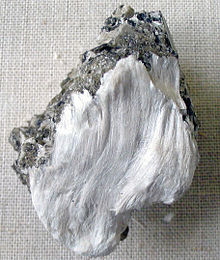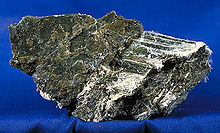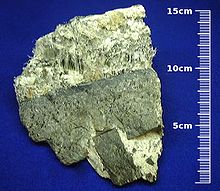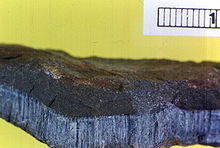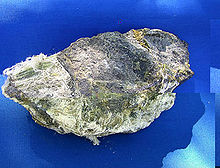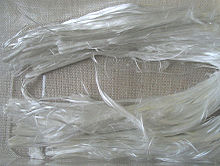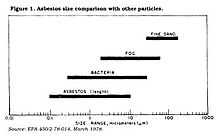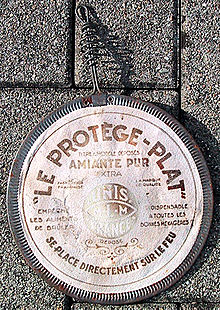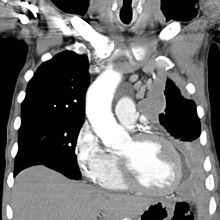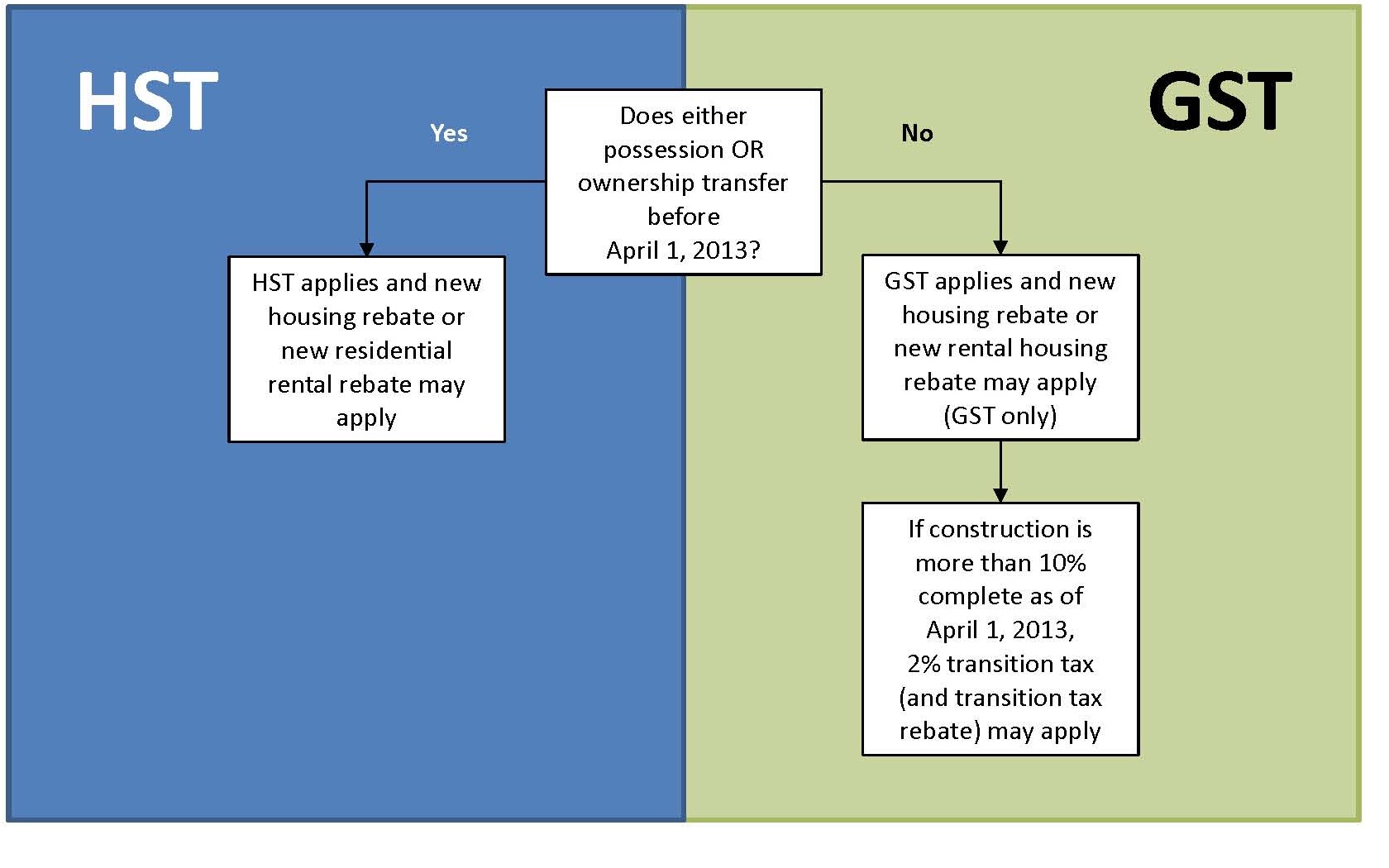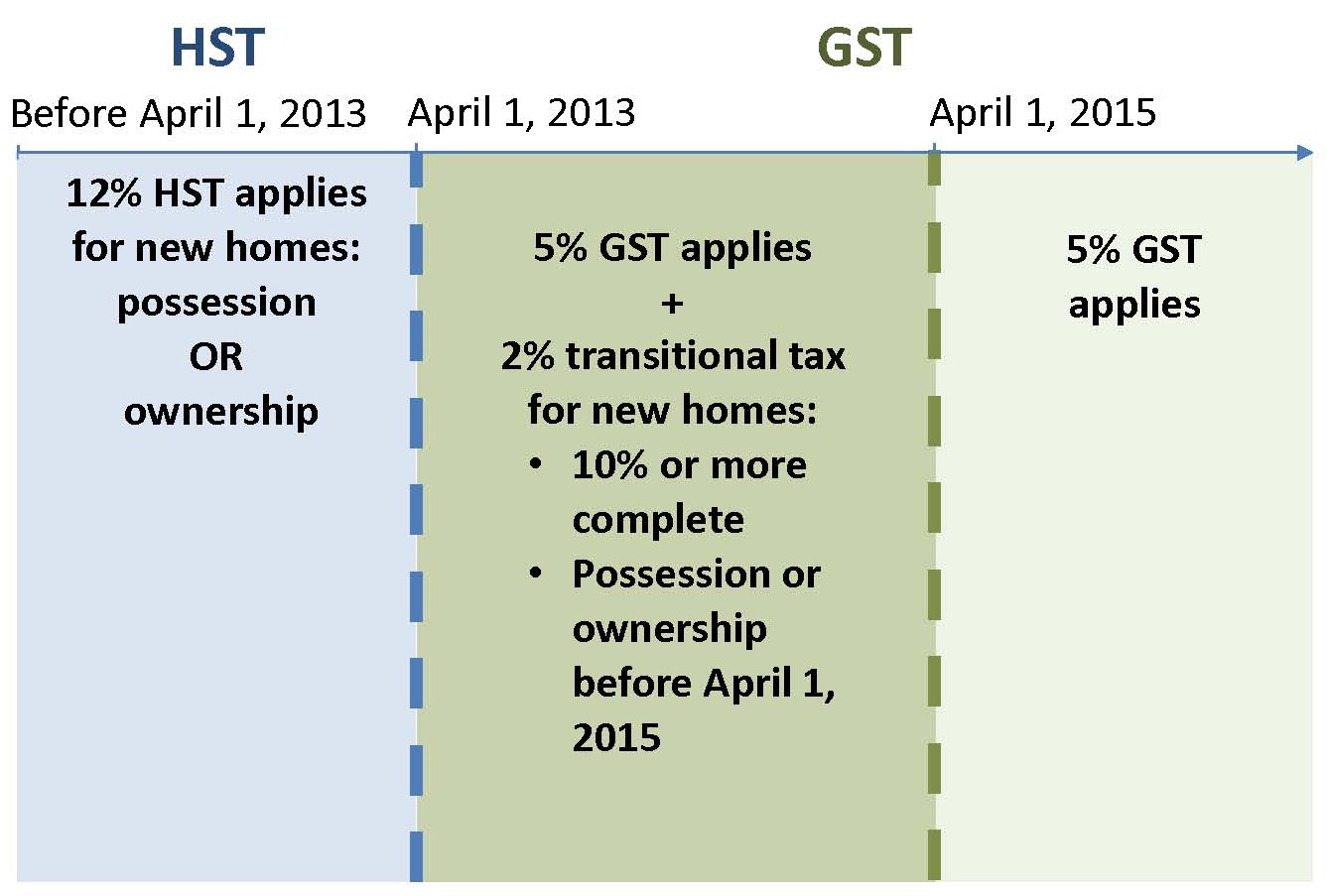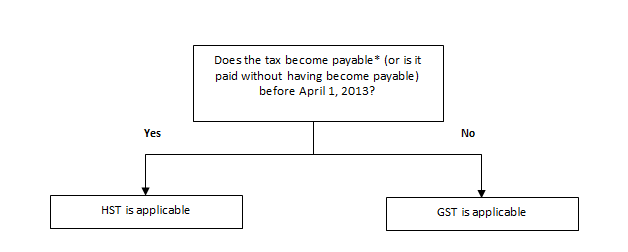Thursday, February 28, 2013 Change Coming to Vancouver's Laneway Housing ProgramChange Coming to Vancouver's Laneway Housing Program| Feb 26, 2013Image by: Adam Blasberg
Vancouver's laneway houses will see a change in regulations. After four years of success, Vancouver looks at increase its laneway housing program by including all single-family housing zonesIn a bid to increase urban density, Vancouver is looking at expanding its laneway housing program. Launched in 2009, the program has seen 800 permits for laneway houses issued, with north of 500 being built over the past four years. While originally six per cent of single-family housing zones were not eligible for laneway houses, this updated program will include all single-family zones in the city. Further amendments will also focus on encouraging people to build one-storey laneway houses (which are less obtrusive to neighbours) and will work towards making the laneway house permit process faster and easier. For the full story on laneway houses, look into the BCBusiness archives at Daniel Wood’s 2011 feature on Vancouver’s laneway homes and the residents who occupy them: Living Small in Laneway Houses. Thursday, February 28, 2013 AsbestosAsbestosFrom Wikipedia, the free encyclopedia
For other uses, see Asbestos (disambiguation).
_jpg/220px-Blue_asbestos_(teased).jpg)
Blue asbestos, teased to show the fibrous nature of the mineral (from mine at Wittenoom, Western Australia)
Asbestos (pronounced pron.: /æsˈbɛstəs/ or /æzˈbɛstəs/) is a set of six naturally occurring silicate minerals used commercially for their desirable physical properties.[1] They all have in common their eponymous, asbestiform habit: long (ca. 1:20 aspect ratio), thin fibrous crystals. The prolonged inhalation of asbestos fibers can cause serious illnesses[2] including malignant lung cancer, mesothelioma, and asbestosis (a type of pneumoconiosis).[3] The European Union has banned all use of asbestos[4] and extraction, manufacture and processing of asbestos products.[5] Asbestos became increasingly popular among manufacturers and builders in the late 19th century because of its sound absorption, average tensile strength, its resistance to fire, heat, electrical and chemical damage, and affordability. It was used in such applications as electrical insulation for hotplate wiring and in building insulation. When asbestos is used for its resistance to fire or heat, the fibers are often mixed with cement (resulting in fiber cement) or woven into fabric or mats. Asbestos mining began more than 4,000 years ago, but did not start large-scale until the end of the 19th century. For a long time, the world's largest asbestos mine was the Jeffrey mine in the town of Asbestos, Quebec.[6] [edit] Types and associated fibersSix minerals types are defined by the United States Environmental Protection Agency as "asbestos" including those belonging to the serpentine class and those belonging to the amphibole class. All six asbestos mineral types are known to be human carcinogens.[7][8] [edit] SerpentineSerpentine class fibers are curly. Chrysotile is the only member of the serpentine class. [edit] ChrysotileChrysotile, CAS No. 12001-29-5, is obtained from serpentinite rocks which are common throughout the world. Its idealized chemical formula is Mg3(Si2O5)(OH)4.[9] Chrysotile appears under the microscope as a white fiber. Chrysotile has been used more than any other type and accounts for about 95% of the asbestos found in buildings in America.[10] Chrysotile is more flexible than amphibole types of asbestos, and can be spun and woven into fabric. Its most common use has been in corrugated asbestos cement roof sheets typically used for outbuildings, warehouses and garages. It may also be found in sheets or panels used for ceilings and sometimes for walls and floors. Chrysotile has been a component in joint compound and some plasters. Numerous other items have been made containing chrysotile, including brake linings, fire barriers in fuseboxes, pipe insulation, floor tiles, and rope seals for boilers.[citation needed] [edit] AmphiboleAmphibole class fibers are needle-like. Amosite, crocidolite, tremolite, anthophyllite and actinolite are members of the amphibole class. [edit] AmositeAmosite, CAS No. 12172-73-5, is a trade name for the amphiboles belonging to the cummingtonite-grunerite solid solution series, commonly from South Africa, named as an acronym for "asbestos mines of South Africa". One formula given for amosite is Fe7Si8O22(OH)2. Amosite is seen under a microscope as a brown fiber. It is found most frequently as a fire retardant in thermal insulation products and ceiling tiles.[10] [edit] CrocidoliteCrocidolite, CAS No. 12001-28-4, is the fibrous form of the amphibole riebeckite, found primarily in southern Africa, but also in Australia and Bolivia. One formula given for crocidolite is Na2Fe2+3Fe3+2Si8O22(OH)2. Crocidolite is seen under a microscope as a blue fiber. Crocidolite commonly occurs as soft friable fibers. Asbestiform amphibole may also occur as soft friable fibers but some varieties such as amosite are commonly straighter. All forms of asbestos are fibrillar in that they are composed of fibers with breadths less than 1 micrometer that occur in bundles and have very great widths. Asbestos with particularly fine fibers is also referred to as "amianthus". [edit] Other materialsOther regulated asbestos minerals, such as tremolite asbestos, CAS No. 77536-68-6, Ca2Mg5Si8O22(OH)2; actinolite asbestos, CAS No. 77536-66-4, Ca2(Mg, Fe)5(Si8O22)(OH)2; and anthophyllite asbestos, CAS No. 77536-67-5, (Mg, Fe)7Si8O22(OH)2; are less commonly used industrially but can still be found in a variety of construction materials and insulation materials and have been reported in the past to occur in a few consumer products. Other natural and not currently regulated asbestiform minerals, such as richterite, Na(CaNa)(Mg, Fe++)5(Si8O22)(OH)2, and winchite, (CaNa)Mg4(Al, Fe3+)(Si8O22)(OH)2. These minerals are thought by some to be no less harmful than tremolite, amosite, or crocidolite.[11] They are referred to as "asbestiform" rather than asbestos. Although the U.S. OSHA has not included them in the asbestos standard, NIOSH and the American Thoracic Society have recommended that they be included as regulated materials. As such, they may still be related to diseases and hazardous.[11] [edit] Producing nationsIn 2009, 2 million tonnes of asbestos were mined worldwide. Russia was the largest producer with about 50% world share followed by China (14%), Brazil (12.5%), Kazakhstan (10.5%) and Canada (9%).[12] In late 2011, Canada's remaining two asbestos mines, both located in the Province of Quebec, halted operations.[13] In September 2012, the newly elected government in the Province of Quebec followed through with an election promise to halt asbestos mining.[14] [edit] History[edit] Early usesAsbestos use in human culture dates back at least 4,500 years, when evidence shows that inhabitants of the Lake Juojärvi region in East Finland strengthened earthenware pots and cooking utensils with the asbestos mineral anthophyllite.[15] The word asbestos comes from the ancient Greek ἄσβεστος, meaning "unquenchable" or "inextinguishable".[1][16] One of the first descriptions of a material that may have been asbestos is in Theophrastus, On Stones, from around 300 BC, although this identification has been questioned.[17] The naming of minerals was not very consistent in ancient times.[citation needed] In both modern and ancient Greek, the usual name for the material known in English as "asbestos" is amiantos ("undefiled", "pure") whence the term for it in, e.g., French amiante. In modern Greek, the word ἀσβεστος or ασβέστης stands consistently and solely for lime.[citation needed] The term asbestos is traceable to Roman naturalist Pliny the Elder's manuscript Natural History, and his use of the term asbestinon, meaning "unquenchable".[1][15][16] While Pliny is popularly credited with recognising the detrimental effects of asbestos on human beings,[18] examination of the primary sources reveals no support for that claim.[19] Wealthy Persians amazed guests by cleaning cloth by exposing it to fire.[when?] For example, according to Tabari, one of the curious items belonging to Khosrow II Parviz, the great Sassanian king (r. 531–579), was a napkin that he cleaned simply by throwing it into fire. Such cloth is believed to have been made of asbestos imported over the Hindu Kush.[20] According to Biruni in his book, Gems, any cloths made of asbestos (Persian: آذرشست, āzarshost) were called shostakeh (Persian: شستكه).[21] Some Persians[who?][when?] believed the fiber was the fur of an animal, called the samandar (Persian: سمندر), which lived in fire and died when exposed to water,[22][better source needed][23] whence the former belief[by whom?] that the salamander could tolerate fire.[citation needed] Charlemagne, the first Holy Roman Emperor (800–814), is said[by whom?] to have had a tablecloth made of asbestos.[24] Marco Polo recounts having been shown, in a place he calls Ghinghin talas, "a good vein from which the cloth which we call of salamander, which cannot be burnt if it is thrown into the fire, is made . . . ."[25] Some archeologists[who?] believe that ancients made shrouds of asbestos, wherein they burned the bodies of their kings, in order to preserve only their ashes, and prevent their being mixed with those of wood or other combustible materials commonly used in funeral pyres.[26][page needed][unreliable source?] Others[who?] assert that the ancients used asbestos to make perpetual wicks for sepulchral or other lamps.[22][better source needed] In more recent centuries, asbestos was indeed used for this purpose. Although asbestos causes skin to itch upon contact, ancient literature indicates that it was prescribed for diseases of the skin, and particularly for the itch. It is possible that they[who?] used the term asbestos for soapstone, because the two terms have often been confused throughout history.[26][page needed][unreliable source?] [edit] Industrial eraThe U.S. asbestos industry began in 1858 when fibrous anthophyllite was mined for use as asbestos insulation by the Johns Company, a predecessor to the current Johns Manville at a quarry at Ward's Hill on Staten Island, New York.[27] Asbestos became more widespread during the industrial revolution; in 1866 it was used as insulation in the U.S. and Canada. Development of the first commercial asbestos mine began in 1874 in the Appalachian foothills of Quebec.[28] By the mid 20th century uses included fire retardant coatings, concrete, bricks, pipes and fireplace cement, heat, fire, and acid resistant gaskets, pipe insulation, ceiling insulation, fireproof drywall, flooring, roofing, lawn furniture, and drywall joint compound. In Japan, particularly after World War II, asbestos was used in the manufacture of ammonium sulfate for purposes of rice production, sprayed upon the ceilings, iron skeletons, and walls of railroad cars and buildings (during the 1960s), and used for energy efficiency reasons as well. Production of asbestos in Japan peaked in 1974 and went through ups and downs until about 1990, when production began to drop severely.[29] [edit] Discovery of toxicityFor additional chronological citations, see also, List of asbestos disease medical articles The first documented death related to asbestos was in 1906.[citation needed] In the early 1900s researchers began to notice a large number of early deaths and lung problems in asbestos mining towns. The first diagnosis of asbestosis was made in the UK in 1924. By the 1930s, the UK regulated ventilation and made asbestosis an excusable work-related disease, followed by the U.S about ten years later.[9] The term mesothelioma was first used in medical literature in 1931; its association with asbestos was first noted sometime in the 1940s. Approximately 100,000 people in the United States have died, or will die, from asbestos exposure related to ship building. In the Hampton Roads area, a shipbuilding center, mesothelioma occurrence is seven times the national rate.[30] Thousands of tons of asbestos were used in World War II ships to wrap the pipes, line the boilers, and cover engine and turbine parts. There were approximately 4.3 million shipyard workers in the United States during WWII; for every thousand workers about fourteen died of mesothelioma and an unknown number died from asbestosis.[31] The United States government and asbestos industry have been criticized for not acting quickly enough to inform the public of dangers, and to reduce public exposure. In the late 1970s court documents proved that asbestos industry officials knew of asbestos dangers since the 1930s and had concealed them from the public.[31] In Australia, asbestos was widely used in construction and other industries between 1945 and 1980. From the 1970s there was increasing concern about the dangers of asbestos, and its use was phased out. Mining ceased in 1983. The use of asbestos was phased out in 1989 and banned entirely in December 2003. The dangers of asbestos are now well known in Australia and there is help and support for sufferers from asbestosis or mesothelioma.[32] [edit] Specific products[edit] Serpentine groupSerpentine minerals have a sheet or layered structure. Chrysotile is the only asbestos mineral in the serpentine group. In the United States, chrysotile has been the most commonly used type of asbestos. According to the U.S. EPA Asbestos Building Inspectors Manual, chrysotile accounts for approximately 95% of asbestos found in buildings in the United States.[citation needed] Chrysotile is often present in a wide variety of products and materials, including:
In the European Union and Australia it has recently been banned as a potential health hazard[34] and is not used at all. Japan is moving in the same direction, but more slowly. [edit] Amphibole groupAmphiboles including amosite (brown asbestos) and crocidolite (blue asbestos) were formerly used in many products until the early 1980s.[citation needed] Tremolite asbestos constituted a contaminant of many if not all naturally occurring chrysotile deposits. The use of all types of asbestos in the amphibole group was banned in much of the Western world by the mid-1980s, and in Japan by 1995.[citation needed] Some products that included amphibole types of asbestos included the following:
Cigarette manufacturer Lorillard (Kent's filtered cigarette) used crocidolite asbestos in its "Micronite" filter from 1952 to 1956.[35] While mostly chrysotile asbestos fibers were once used in automobile brake pads, shoes, and clutch discs, contaminants of amphiboles were present. Since approximately the mid-1990s, brake pads, new or replacement, have been manufactured instead with linings made of ceramic, carbon, metallic and aramid fiber (Twaron or Kevlar—the same material used in bulletproof vests). Artificial Christmas snow, known as flocking, was previously made with asbestos.[36] [edit] Health problemsAll types of asbestos fibers are known to cause serious health hazards in humans.[37][38][39] While it is agreed that amosite and crocidolite are the most hazardous asbestos fiber types, chrysotile asbestos has produced tumors in animals and is a recognized cause of asbestosis and malignant mesothelioma in humans.[40] Mesotheliomas have been observed in people who were occupationally exposed to chrysotile, family members of the occupationally exposed, and residents who lived close to asbestos factories and mines.[41] According to the NCI, "A history of asbestos exposure at work is reported in about 70 percent to 80 percent of all cases. However, mesothelioma has been reported in some individuals without any known exposure to asbestos."[42] The most common diseases associated with chronic exposure to asbestos include: asbestosis and pleural abnormalities (mesothelioma, lung cancer).[43] Asbestosis has been reported primarily in asbestos workers, and appears to require long-term exposure, high concentration for the development of the clinical disease. There is also a long latency period (incubation period of an infectious disease, before symptoms appear) of about 12 to 20 years.[44] Studies have shown an increased risk of lung cancer among smokers who are exposed to asbestos compared to nonsmokers.[45] Asbestos exposure becomes a health concern when high concentrations of asbestos fibers are inhaled over a long time period.[46] People who become ill from inhaling asbestos are often those who are exposed on a day-to-day basis in a job where they worked directly with the material. As a person's exposure to fibers increases, because of being exposed to higher concentrations of fibers and/or by being exposed for a longer time, then that person's risk of disease also increases. Disease is very unlikely to result from a single, high-level exposure, or from a short period of exposure to lower levels.[46] [edit] Possible Mechanisms of CarcinogenicityStanton and Layard hypothesized in 1977–78 that toxicity of fibrous materials is not initiated by chemical effects,[47] that is any trigger-effects of asbestos must presumably be physical, such as (A) mechanical damage or (B) unwanted signal channels (a plausible property for slender transparent fibres) which might disrupt normal cell activity—especially mitosis. (A) Mechanical Damage. There is experimental evidence that very slim fibers (<60 nm, <0.06 μm in breadth) do tangle destructively with chromosomes (being of comparable size).[48][49] This is likely to cause the sort of mitosis disruption expected in cancer. (B) Unwanted Signal channels. This has recently been explored theoretically, but not yet experimentally. The theory argues that this effect would only be feasible for asbestos fibers >100 nm in breadth (>150 nm in the case of chrysotile), which suggests that we should be on the look-out for a possible mixture of different mechanisms for the different fiber-diameter-ranges.[50][51] One popular idea of the causal chain is (1) Asbestos fiber → → (3) inflammation → (4) other pathology. While that may be true, it does not explain "(2), the actual trigger":
[edit]Main article: Asbestos-related diseases
[edit] Chemistry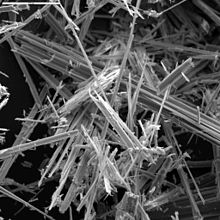
Asbestos fibers (SEM micrograph)
Asbestos fibers are invisible to the unaided human eye because their size is about 3–20 µm wide and can be as slim as 0.01 µm. Human hair ranges in size from 17 to 181 µm in breadth.[53] Fibers ultimately form because when these minerals originally cooled and crystallized, they formed by the polymeric molecules lining up parallel with each other and forming oriented crystal lattices. These crystals thus have three cleavage planes, and in this case, there are two cleavage planes which are much weaker than the third. When sufficient force is applied, they tend to break along their weakest directions, resulting in a linear fragmentation pattern and hence a fibrous form. This fracture process can keep occurring and one larger asbestos fiber can ultimately become the source of hundreds of much thinner and smaller fibers. When fibers or asbestos structures from asbestos containing materials(ACM) become airborne, the process is called primary release. Primary release mechanisms include abrasion, impaction, fallout, air erosion, vibration, and fire damage. Secondary release occurs when settled asbestos fibers and structures are resuspended as a result of human activities. In unoccupied buildings or during unoccupied periods, fiber release typically occurs by fallout or is induced by vibration or air erosion.[54] Friability of a product containing asbestos means that it is so soft and weak in structure that it can be broken with simple finger crushing pressure. Friable materials are of the most initial concern because of their ease of damage. The forces or conditions of usage that come into intimate contact with most non-friable materials containing asbestos are substantially higher than finger pressure. [edit] Identification and AssessmentA fiber cannot be identified or ruled out as asbestos, either using the naked eye or by simply looking at a fiber under a regular microscope. The most common methods of identifying asbestos fibers are by using polarized light microscopy (PLM) or transmission electron microscopy (TEM). PLM is less expensive, but TEM is more precise and can be used at lower concentrations of asbestos. If asbestos abatement is performed, completion of the abatement is verified using visual confirmation and may also involve air sampling. Air samples are typically analyzed using phase contrast microscopy (PCM). PCM involves counting fibers on a filter using a microscope. Airborne occupational exposure limits for asbestos are based on using the PCM method. The American Conference of Governmental Industrial Hygienists has a recommended Threshold Limit Value (TLV) for asbestos of 0.1 fibers/mL over an 8 hour shift. OSHA in the United States and occupational health and safety regulatory jurisdictions in Canada use 0.1 fibers/mL over an 8 hour shift as their exposure limits.[55] [edit] Common Building Materials Containing AsbestosMost products manufactured today do not contain asbestos. In the industrialized world, asbestos was phased out of building products mostly in the 1970s with most of the remainder phased out by the 1980s. Asbestos containing building materials in residences includes a variety of products, such as: stiple used in textured walls and ceilings; drywall joint filler compound; asbestos contaminated vermiculite, vinyl floor tile; vinyl sheet flooring; window putty; mastic; cement board; furnace tape; and stucco. Other sources of asbestos containing materials include fireproofing and acoustic materials.[56] [edit] ExposureAsbestos exposure becomes an issue if asbestos containing materials become airborne, such as due to deterioration or damage. Building occupants may be exposed to asbestos, but those most at risk are persons who purposely disturb materials, such as maintenance/construction workers. Housekeeping/custodial employees may be at increased risk as they may potentially clean up damaged or deteriorated asbestos containing materials without knowing that the material contains asbestos. Asbestos abatement/remediation workers and emergency personnel such as firefighters may also become exposed.[57] [edit] Environmental asbestosAsbestos can be found naturally in the air outdoors and in some drinkable water, including water from natural sources.[58] Studies have shown that members of the general (non-occupationally exposed) population have tens of thousands to hundreds of thousands of asbestos fibers in each gram of dry lung tissue, which translates into millions of fibers and tens of thousands of asbestos bodies in every person's lungs.[59] Asbestos from natural geologic deposits is known as "naturally occurring asbestos" (NOA). Health risks associated with exposure to NOA are not yet fully understood, and current US federal regulations do not address exposure from NOA. Many populated areas are in proximity to shallow, natural deposits which occur in 50 of 58 California counties and in 19 other U.S. states. In one study, data was collected from 3,000 mesothelioma patients in California and 890 men with prostate cancer, a malignancy not known to be related to asbestos. The study found a correlation between the incidence of mesotheliomas and the distance a patient lived from known deposits of rock likely to include asbestos; the correlation was not present when the incidence of prostate cancer was compared with the same distances. According to the study, risk of mesothelioma declined by 6% for every 10 km that an individual had lived away from a likely asbestos source.[60] Portions of El Dorado County, California are known to contain natural amphibole asbestos formations at the surface.[60][61] The USGS studied amphiboles in rock and soil in the area in response to an EPA sampling study and subsequent criticism of the EPA study. The EPA study was refuted by its own peer reviewers and never completed or published. The study found that many amphibole particles in the area meet the counting rule criteria used by the EPA for chemical and morphological limits, but do not meet morphological requirements for commercial-grade-asbestos. The executive summary pointed out that even particles that do not meet requirements for commercial-grade-asbestos may be a health threat and suggested a collaborative research effort to assess health risks associated with "Naturally Occurring Asbestos." However, the main criticism pointed at EPA was that their testing was conducted in small isolated areas of El Dorado where there were no amphibole asbestos deposits, thus the language regarding amphibole, nonfibrous "particles". Actual surface amphibole deposits in residential areas were ignored for testing purposes. Thus no final findings were published by ATSDR since the criticism was correct and the effort of combined EPA/ATSDR teams were wasted time and money.[62] Great deals of Fairfax County, Virginia were also found to be underlain with tremolite. The county monitored air quality at construction sites, controlled soil taken from affected areas, and required freshly developed sites to lay 6 inches (150 mm) of clean, stable material over the ground.[60] Globally, collected samples from Antarctic ice indicate chrysotile asbestos has been a ubiquitous contaminant of the environment for at least 10,000 years. Snow samples in Japan have shown ambient background levels are one to two orders of magnitude higher in urban than in rural areas. Higher concentrations of airborne asbestos fibers are reported in urban areas where there is more ACM (asbestos containing materials) and mechanisms of release (vehicles braking and weathering of asbestos cement materials); concentrations in the range of 1–20 ng/m^3 have been reported. Fibers longer than 5μm are rarely found in rural areas. Ambient concentrations using TEM analysis have been based on mass measurements.[54] Thursday, February 28, 2013 Open House. Open House on Saturday, March 2, 2013 2:00 pm - 4:30 pmCategories:Arbutus, Vancouver West Real Estate
Please visit our Open House at 3630 TRAFALGAR ST in Vancouver.
Open House on Saturday, March 2, 2013 2:00 pm - 4:30 pm
Gorgeous Brand New Home on Trafalgar Street with 4,338 square feet of beautiful living. 53' x 120' Lot size with a 4 car garage. Top level features 4 bedrooms & 3 ensuites, Spa inspired master bathroom with a large walk in closet. Main level offers 10 foot ceilings, open living and dining area, a large office, gourmet kitchen with top of the line appliances a chinese (spice/wok) kitchen and mud room. Hand scraped birch floors, gorgeous chandeliers and large windows to let the sun shine in. Wolf and Sub-Zero stainless steel appliances make this gourmet kitchen one you will never want to leave. Lower level contains a fantastic one bedroom fully finishd suite with laundry, PLUS a media room that makes you feel like you are in a movie theatre, custom built wine room, recreation room and powder room. What more could you ask for? Call today to view. 2-5-10 National Home Warranty. School Catchment: Elementary - K - 7 Trafalgar Elementary Wednesday, February 27, 2013 Open House. Open House on Saturday, March 2, 2013 2:00 pm - 4:00 pmCategories:Kitsilano, Vancouver West Real Estate
Please visit our Open House at 3057 13TH AVE W in Vancouver.
Open House on Saturday, March 2, 2013 2:00 pm - 4:00 pm
This is a fantastic 4 bedroom, 4 full 2 half bathroom Kitsilano home on a gorgeous tree-lined street sitting on a level 33'x 122' lot. Great for families and perfect for entertaining! 3 bedrooms and 3 ensuites on top level.
Main floor has dark wood floors, open concept living, dining and family room. Lower level has it all, media room, recreation room, guest (or nanny) bedroom and 1.5 bathrooms.
Large deck, Air Conditioning, 2 car garage, Security System with TV, HRV. 2-5-10 Warranty. Close to great shopping and restaurants on Broadway, parks and schools! Elementary - K -7 Carnarvon Elementary; Secondary - 8 -12 Kitsilano Secondary. Open House Saturday and Sunday from 2-4pm Tuesday, February 26, 2013 Open House. Open House on Tuesday, February 26, 2013 10:00 am - 12:00 pm Newly Staged with beautiful furniture - come see it again!Categories:Kitsilano, Vancouver West Real Estate
Please visit our Open House at 3057 13TH AVE W in Vancouver.
Open House on Tuesday, February 26, 2013 10:00 am - 12:00 pm
Newly Staged with beautiful furniture - come see it again!
This is a fantastic 4 bedroom, 4 full 2 half bathroom Kitsilano home on a gorgeous tree-lined street sitting on a level 33'x 122' lot. Great for families and perfect for entertaining! 3 bedrooms and 3 ensuites on top level.
Main floor has dark wood floors, open concept living, dining and family room. Lower level has it all, media room, recreation room, guest (or nanny) bedroom and 1.5 bathrooms.
Large deck, Air Conditioning, 2 car garage, Security System with TV, HRV. 2-5-10 Warranty. Close to great shopping and restaurants on Broadway, parks and schools! Elementary - K -7 Carnarvon Elementary; Secondary - 8 -12 Kitsilano Secondary. Open House Saturday and Sunday from 2-4pm Tuesday, February 26, 2013 Open House. Open House on Wednesday, February 27, 2013 10:00 am - 12:00 pm Beautifully staged, another amazing home by PRBH Development.Categories:Arbutus, Vancouver West Real Estate
Please visit our Open House at 3630 TRAFALGAR ST in Vancouver.
Open House on Wednesday, February 27, 2013 10:00 am - 12:00 pm
Beautifully staged, another amazing home by PRBH Development.
Gorgeous Brand New Home on Trafalgar Street with 4,338 square feet of beautiful living. 53' x 120' Lot size with a 4 car garage. Top level features 4 bedrooms & 3 ensuites, Spa inspired master bathroom with a large walk in closet. Main level offers 10 foot ceilings, open living and dining area, a large office, gourmet kitchen with top of the line appliances a chinese (spice/wok) kitchen and mud room. Hand scraped birch floors, gorgeous chandeliers and large windows to let the sun shine in. Wolf and Sub-Zero stainless steel appliances make this gourmet kitchen one you will never want to leave. Lower level contains a fantastic one bedroom fully finishd suite with laundry, PLUS a media room that makes you feel like you are in a movie theatre, custom built wine room, recreation room and powder room. What more could you ask for? Call today to view. 2-5-10 National Home Warranty. School Catchment: Elementary - K - 7 Trafalgar Elementary Sunday, February 24, 2013 Open House. Open House on Sunday, February 24, 2013 2:00 pm - 4:00 pmCategories:Kitsilano, Vancouver West Real Estate
Please visit our Open House at 3057 13TH AVE W in Vancouver.
Open House on Sunday, February 24, 2013 2:00 pm - 4:00 pm
This is a fantastic 4 bedroom, 4 full 2 half bathroom Kitsilano home on a gorgeous tree-lined street sitting on a level 33'x 122' lot. Great for families and perfect for entertaining! 3 bedrooms and 3 ensuites on top level.
Main floor has dark wood floors, open concept living, dining and family room. Lower level has it all, media room, recreation room, guest (or nanny) bedroom and 1.5 bathrooms.
Large deck, Air Conditioning, 2 car garage, Security System with TV, HRV. 2-5-10 Warranty. Close to great shopping and restaurants on Broadway, parks and schools! Elementary - K -7 Carnarvon Elementary; Secondary - 8 -12 Kitsilano Secondary. Open House Saturday and Sunday from 2-4pm Sunday, February 24, 2013 Open House. Open House on Sunday, February 24, 2013 2:00 pm - 4:30 pmCategories:Arbutus, Vancouver West Real Estate
Please visit our Open House at 3630 TRAFALGAR ST in Vancouver.
Open House on Sunday, February 24, 2013 2:00 pm - 4:30 pm
Gorgeous Brand New Home on Trafalgar Street with 4,338 square feet of beautiful living. 53' x 120' Lot size with a 4 car garage. Top level features 4 bedrooms & 3 ensuites, Spa inspired master bathroom with a large walk in closet. Main level offers 10 foot ceilings, open living and dining area, a large office, gourmet kitchen with top of the line appliances a chinese (spice/wok) kitchen and mud room. Hand scraped birch floors, gorgeous chandeliers and large windows to let the sun shine in. Wolf and Sub-Zero stainless steel appliances make this gourmet kitchen one you will never want to leave. Lower level contains a fantastic one bedroom fully finishd suite with laundry, PLUS a media room that makes you feel like you are in a movie theatre, custom built wine room, recreation room and powder room. What more could you ask for? Call today to view. 2-5-10 National Home Warranty. School Catchment: Elementary - K - 7 Trafalgar Elementary Thursday, February 21, 2013 Open House. Open House on Saturday, February 23, 2013 2:00 pm - 4:30 pmCategories:Arbutus, Vancouver West Real Estate
Please visit our Open House at 3630 TRAFALGAR ST in Vancouver.
Open House on Saturday, February 23, 2013 2:00 pm - 4:30 pm
Gorgeous Brand New Home on Trafalgar Street with 4,338 square feet of beautiful living. 53' x 120' Lot size with a 4 car garage. Top level features 4 bedrooms & 3 ensuites, Spa inspired master bathroom with a large walk in closet. Main level offers 10 foot ceilings, open living and dining area, a large office, gourmet kitchen with top of the line appliances a chinese (spice/wok) kitchen and mud room. Hand scraped birch floors, gorgeous chandeliers and large windows to let the sun shine in. Wolf and Sub-Zero stainless steel appliances make this gourmet kitchen one you will never want to leave. Lower level contains a fantastic one bedroom fully finishd suite with laundry, PLUS a media room that makes you feel like you are in a movie theatre, custom built wine room, recreation room and powder room. What more could you ask for? Call today to view. 2-5-10 National Home Warranty. School Catchment: Elementary - K - 7 Trafalgar Elementary Wednesday, February 20, 2013 A Sellers Best Bet is to list and sell one bedroom condos in Downtown Vancouver = list price between $300,000 - $400,000.According to the SnapStats Report for January 2013, A Sellers Best Bet is to list and sell one bedroom condos in Downtown Vancouver = list price between $300,000 - $400,000. If you have a condo and would like to know my recommended list price, contact me today. Wednesday, February 20, 2013 What is CMHC Mortgage Loan Insurance?
http://www.cmhc-schl.gc.ca/en/co/moloin/moloin_010.cfmWednesday, February 20, 2013 Open House. Open House on Saturday, February 23, 2013 2:00 pm - 4:00 pmCategories:Kitsilano, Vancouver West Real Estate
Please visit our Open House at 3057 13TH AVE W in Vancouver.
Open House on Saturday, February 23, 2013 2:00 pm - 4:00 pm
This is a fantastic 4 bedroom, 4 full 2 half bathroom Kitsilano home on a gorgeous tree-lined street sitting on a level 33'x 122' lot. Great for families and perfect for entertaining! 3 bedrooms and 3 ensuites on top level. Main floor has wood floors, open concept living, dining and family room. Lower level has it all, media room, recreation room, guest (or nanny) bedroom and 1.5 bathrooms. Large deck, Air Conditioning, 2 car garage, Security System with TV, HRV. 2-5-10 Warranty. Close to great shopping and restaurants on Broadway, parks and schools! Elementary - K -7 Carnarvon Elementary; Secondary - 8 -12 Kitsilano Secondary. Open House Saturday and Sunday from 2-4pm Tuesday, February 19, 2013 HST to PST: Transition Rules for Real PropertyHST to PST: Transition Rules for Real PropertyLast update: February 18, 2013 On August 26, 2011, the provincial government announced that it will eliminate the Harmonized Sales Tax (HST) by March 31, 2013. Commencing April 1, 2013, in BC the HST will be replaced by the federal Goods and Services Tax (GST) and the BC Provincial Sales Tax (PST). On February 17, 2012, the BC Ministry of Finance and the federal Ministry of Finance announced general transition rules for real property. The following questions and answers are intended to provide clarity regarding sales of new housing at a high level. For advice about specific transactions and situations, BCREA suggests individuals seek legal and/or accounting advice, as appropriate. For more information, see:
As details are finalized, this page will be updated with the latest information. For a printable version of the information on this page, click here. Tuesday, February 19, 2013 New property listed in Dunbar, Vancouver WestCategories:Dunbar, Vancouver West Real Estate I have listed a new property at 3540 KING EDWARD AVE W in Vancouver.
European quality built new home. Legal 2 bedroom suite with separate address entrance, laundry, 3 car garage with additional RV parking. Very quiet with wonderful family room and kitchen open to garden and barbecue area. Open House Sun Feb17th, 2-4pm. Tuesday, February 19, 2013 New property listed in Arbutus, Vancouver WestCategories:Arbutus, Vancouver West Real Estate I have listed a new property at 3292 16TH AVE W in Vancouver.
Sitting on a 53' x 120' corner lot is a high quality 4135 sf house in 3 levels with superb layout designed with Asian elements and good Feng Shui! Total 7 bedrooms + 5 baths, extensive use of granite countertops and stone tiles and a hugebalcony to enjoy BBQ and sunshine. Beautiful landscaping in front and back yard. Convenient location with short distance to Lord Byng High School, Elizabeth Elementary and UBC. Pleasure to show! Tuesday, February 19, 2013 New property listed in Dunbar, Vancouver WestCategories:Dunbar, Vancouver West Real Estate I have listed a new property at 3568 28TH AVE W in Vancouver.
Total 4651 sq ft luxurious living space!! This absolutely gorgeous home comes with an incredible 2 level 756 sq ft laneway house completed with independent address. New home warranty, radiant floor heating & alarm system. Main house has 3storey, over 3,800 sq ft furnished with superior workmanship & material: extensive use of granite, excellent millwork, beautiful wood flooring, main & wok kitchen, top brand appliances. 4 roomy ensuite up, master ensuite with Jacuzzi & deluxe steam/massage shower stall. Functional basement includes 1 bedroom suite with separate entrance & alarm, stunning theatre, sauna, wet bar with wine cooler. Lord Byng Secondary & Kitchener Elem school catchments. Tuesday, February 19, 2013 New property listed in Arbutus, Vancouver WestCategories:Arbutus, Vancouver West Real Estate I have listed a new property at 2450 22ND AVE W in Vancouver.
PRIME Arbutus LOCATION !! Just within minutes walk to Trafalgar Elementary & close by Prince of Wales Secondary. This custom & rainscreen constructed home offers over 3700 sq. ft. luxurious living with 6 bdrms plus den, 5.5 baths, gourmetkitchen as well as WOK kitchen, sauna & steam shower, wet bar, recreation & media rooms plus 4-car garage. Supreme finishings featuring extensive use of granite, hardwood flooring throughout, airconditioning, HRV, radiant floor heating, deluxe custom window coverings, security monitoring, central vacuum, sprinkler systems, large covered PORCH with F/P & gas hook up for BBQ, BOSE theatre sound system, top of line appliances like BOSCH & many more. Don't miss this !!! Tuesday, February 19, 2013 Open House. Open House on Tuesday, February 19, 2013 10:00 am - 12:00 pm Beautifully Staged - come have a look!Categories:Kitsilano, Vancouver West Real Estate
Please visit our Open House at 3057 13TH AVE W in Vancouver.
Open House on Tuesday, February 19, 2013 10:00 am - 12:00 pm
Beautifully Staged - come have a look!
This is a fantastic 4 bedroom, 4 full 2 half bathroom Kitsilano home on a gorgeous tree-lined street sitting on a level 33'x 122' lot. Great for families and perfect for entertaining! 3 bedrooms and 3 ensuites on top level. Main floor has wood floors, open concept living, dining and family room. Lower level has it all, media room, recreation room, guest (or nanny) bedroom and 1.5 bathrooms. Large deck, Air Conditioning, 2 car garage, Security System with TV, HRV. 2-5-10 Warranty. Close to great shopping and restaurants on Broadway, parks and schools! Elementary - K -7 Carnarvon Elementary; Secondary - 8 -12 Kitsilano Secondary. Open House Saturday and Sunday from 2-4pm Tuesday, February 19, 2013 Open House. Open House on Wednesday, February 20, 2013 10:00 am - 12:00 pmCategories:Arbutus, Vancouver West Real Estate
Please visit our Open House at 3630 TRAFALGAR ST in Vancouver.
Open House on Wednesday, February 20, 2013 10:00 am - 12:00 pm
Gorgeous Brand New Home on Trafalgar Street with 4,338 square feet of beautiful living. 53' x 120' Lot size with a 4 car garage. Top level features 4 bedrooms & 3 ensuites, Spa inspired master bathroom with a large walk in closet. Main level offers 10 foot ceilings, open living and dining area, a large office, gourmet kitchen with top of the line appliances a chinese (spice/wok) kitchen and mud room. Hand scraped birch floors, gorgeous chandeliers and large windows to let the sun shine in. Wolf and Sub-Zero stainless steel appliances make this gourmet kitchen one you will never want to leave. Lower level contains a fantastic one bedroom fully finishd suite with laundry, PLUS a media room that makes you feel like you are in a movie theatre, custom built wine room, recreation room and powder room. What more could you ask for? Call today to view. 2-5-10 National Home Warranty. School Catchment: Elementary - K - 7 Trafalgar Elementary Thursday, February 14, 2013 Open House. Open House on Saturday, February 16, 2013 2:00 pm - 4:00 pmCategories:Kitsilano, Vancouver West Real Estate
Please visit our Open House at 3057 13TH AVE W in Vancouver.
Open House on Saturday, February 16, 2013 2:00 pm - 4:00 pm
New Year - New Home! Make an appointment today to view this Kitsilano 4 bedroom, 4 full 2 half bathroom home on a gorgeous tree-lined street sitting on a level 33'x 122' lot. Great for families and perfect for entertaining! 3 bedrooms and 3 ensuites on top level. Main floor has wood floors, open concept living, dining and family room. Lower level has it all, media room, recreation room, guest (or nanny) bedroom and 1.5 bathrooms. Large deck, Air Conditioning, 2 car garage, Security System with TV, HRV. 2-5-10 Warranty. Close to great shopping and restaurants on Broadway, parks and schools! Elementary - K -7 Carnarvon Elementary; Secondary - 8 -12 Kitsilano Secondary. Open House Tuesday, February 5th from 10am - 12pm. Categories: Arbutus, Vancouver West Real Estate | Brighouse, Richmond Real Estate | Cambie, Vancouver West Real Estate | Downtown VW, Vancouver West Real Estate | Dubrovnik, Croatia, Old Town Real Estate | Dunbar, Vancouver West Real Estate | Fairview VW, Vancouver West Real Estate | False Creek North, Vancouver West Real Estate | Government Road, Burnaby North Real Estate | Grandview VE, Vancouver East Real Estate | Hastings, Vancouver East Real Estate | Kerrisdale, Vancouver West Real Estate | Kitsilano, Vancouver West Real Estate | Metrotown, Burnaby South Real Estate | Mount Pleasant VE, Vancouver East Real Estate | Mount Pleasant VW, Vancouver West Real Estate | Oakridge VW, Vancouver West Real Estate | Point Grey, Vancouver West Real Estate | Quay, New Westminster Real Estate | Quilchena, Vancouver West Real Estate | Shaughnessy, Vancouver West Real Estate | South Granville, Vancouver West Real Estate | Vancouver Real Estate |
